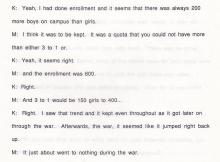Renovating East College for Women over Summer
Dean Ernest A. Vuilleumier reported to the Board of Trustees that the college had rented two fraternity houses (Phi Delta Theta and Beta Theta Pi) in order to provide additional housing for female students. According to Vuilleumier, the return of fraternity members to campus would require that the college develop an alternative form of housing for female students. Therefore, the dean recommended that the college convert East College into a women's dormitory.



